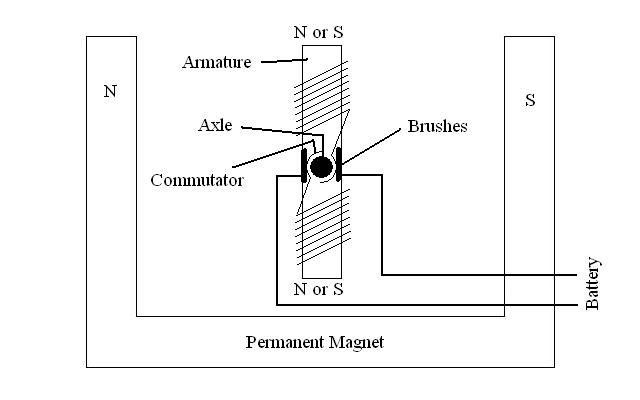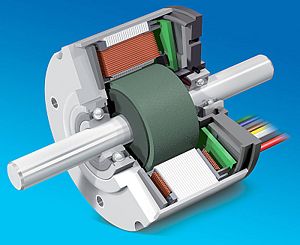DC Motor: Difference between revisions
Wesley.brown (talk | contribs) No edit summary |
Wesley.brown (talk | contribs) No edit summary |
||
| Line 17: | Line 17: | ||
A brushless DC motor is essentially a brushed DC motor that has been turned inside out. The permanent magnet which was the stator is now moved to the rotor that spins and the electromagnet becomes the stator which does not move. Because the electromagnet does not move it can be made with more than two poles which eliminates the possibility of the motor being stuck 180 degrees out of phase. With the use of transistors and a computer the poles of the electromagnetic stator can be turned on and off at time intervals that cause the permanent magnet (rotor) to spin around the stator. Below is a picture of a brushless motor in which the permanent magnet can be seen at the center attached to the spinning output shaft and the electromagnetic windings can be seen on the outside. |
A brushless DC motor is essentially a brushed DC motor that has been turned inside out. The permanent magnet which was the stator is now moved to the rotor that spins and the electromagnet becomes the stator which does not move. Because the electromagnet does not move it can be made with more than two poles which eliminates the possibility of the motor being stuck 180 degrees out of phase. With the use of transistors and a computer the poles of the electromagnetic stator can be turned on and off at time intervals that cause the permanent magnet (rotor) to spin around the stator. Below is a picture of a brushless motor in which the permanent magnet can be seen at the center attached to the spinning output shaft and the electromagnetic windings can be seen on the outside. |
||
[[Image:]]<ref> http://electronics.howstuffworks.com/brushless-motor.htm </ref> |
[[Image:brushless_DC_motor.jpg|thumb|300px| ]]<ref> http://electronics.howstuffworks.com/brushless-motor.htm </ref> |
||
==References== |
==References== |
||
Revision as of 21:28, 11 January 2010
Motors are found everywhere on everything. Try counting all the electric motors you see in a day and I think at the end of the day you will have counted quite high. There are two main types of motors: AC Motors and DC motors. AC and DC stand for Alternating Current and Direct Current respectively. (See AC vs. DC). Now let's talk about how a Direct Current motor works.
DC Motor
First there is a big permanent magnet called a stator with a magnetic field between the north and south ends of the magnet. In this magnetic field there is an armature with wire wound around it. The windings of wire turn the armature into an electromagnet that can switch polarity. As current passes through the wire windings the armature develops a magnetic field and a north and south. The armature is mounted on an axle that can spin and thus tries to orient itself with the magnetic field created by the permanent magnet which surrounds the armature. Because the armature and windings are free to spin they are called a rotor. One type of DC motor has brushes which complete the electric circuit over 180 degrees of the armatures 360 degree rotation. After 180 degrees of rotation one brush loses contact and the other gains contact which reverses the effective direction of the current and the north and south ends of the armature. The armature will then be forced to rotate 180 degrees to be realigned with the magnetic field created by the permanent magnet.<ref> http://electronics.howstuffworks.com/motor1.htm </ref>
This process is what causes the motor to spin. The system is called DC because the direction of the current is reversed by mechanical means (the brushes) and the electric source produces current that travels the same direction the whole time.
 <ref> http://electronics.howstuffworks.com/motor1.htm </ref>
<ref> http://electronics.howstuffworks.com/motor1.htm </ref>
Brushless DC Motor
Some DC motors operate without the use of brushes. The ability to create a brushless DC motor is thanks to transistors. Some of the advantages of a brushless motor include: Higher Efficiency Less Noise Higher Accuracy The armature can have multiple poles<ref> http://electronics.howstuffworks.com/brushless-motor.htm </ref>
A brushless DC motor is essentially a brushed DC motor that has been turned inside out. The permanent magnet which was the stator is now moved to the rotor that spins and the electromagnet becomes the stator which does not move. Because the electromagnet does not move it can be made with more than two poles which eliminates the possibility of the motor being stuck 180 degrees out of phase. With the use of transistors and a computer the poles of the electromagnetic stator can be turned on and off at time intervals that cause the permanent magnet (rotor) to spin around the stator. Below is a picture of a brushless motor in which the permanent magnet can be seen at the center attached to the spinning output shaft and the electromagnetic windings can be seen on the outside.
<ref> http://electronics.howstuffworks.com/brushless-motor.htm </ref>
References
<references/>
